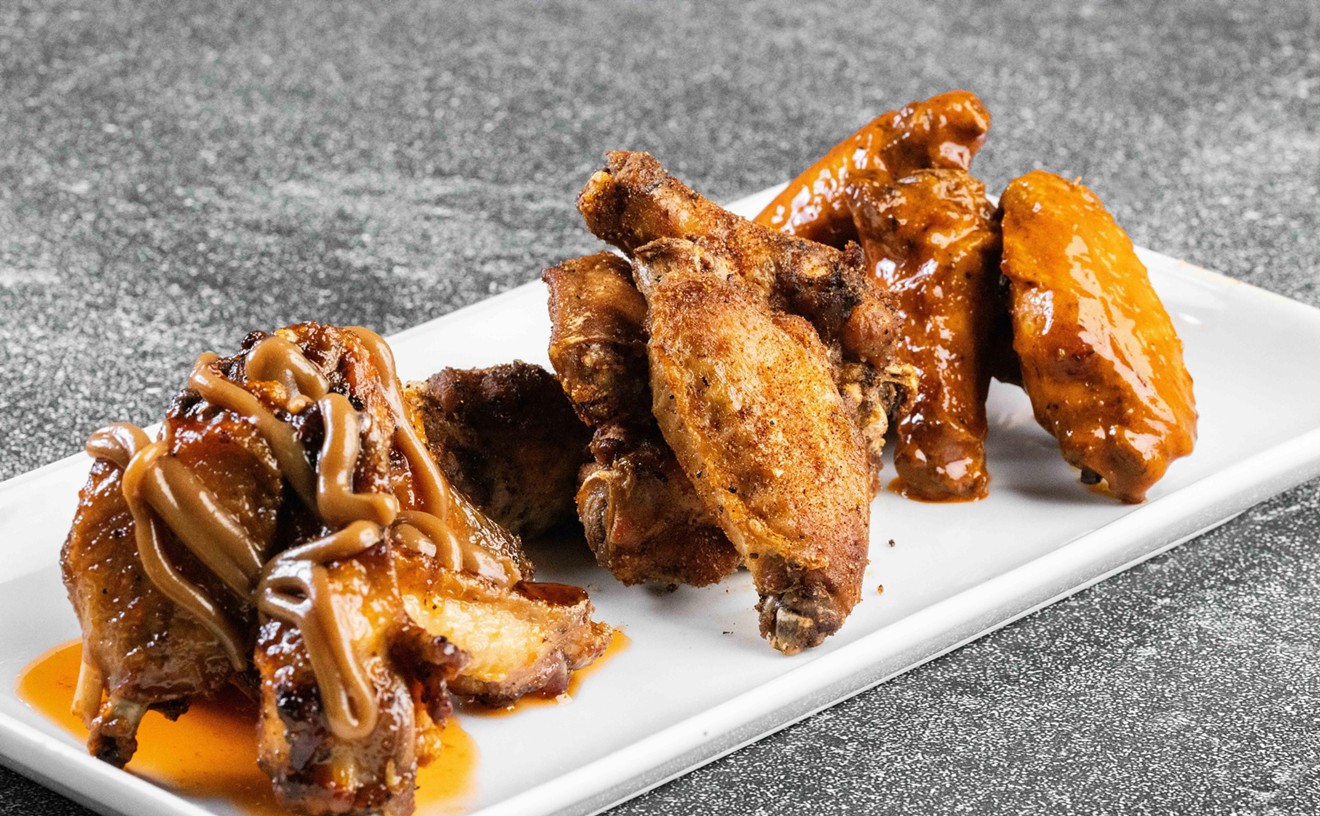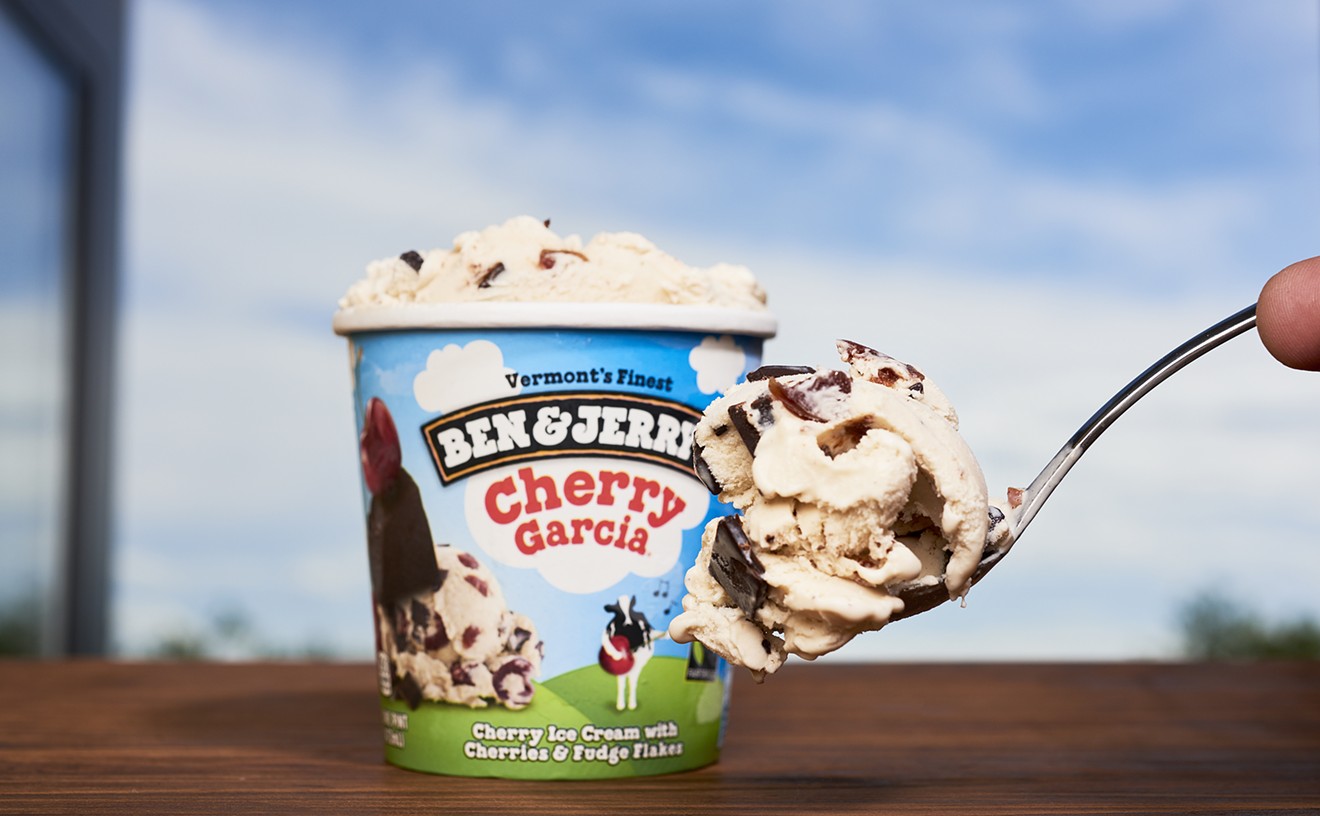In fact, units (male members) assume a certain prominence all over this restaurant, which is done up in garish reds and mindless baubles that would make a pink flamingo blush if it weren't already pink. This motif moves into the bathroom, where Italian language tapes (language tapes in the potty are getting a little trite) play through the speakers. Hanging from the walls are photos of male nude sculptures shot from angles that pull the units into stark prominence, as well as other photos of little boys peeing against walls, in urinals, on the ground, and in the air. I suppose this is the visual version of the trickling-water wee-wee stimulation effect, in case you've forgotten why you came into the bathroom.
"Why is it that every Southern Italian restaurant has to be campy?" snarled my Italian companion.
Roughly translated, Buca di Beppo means "Joe's Basement," and it's designed to be the kind of neighborhood Italian restaurant that used to be tucked under a building. But instead of being escorted past the sump pump and around the water heater, you're ushered past the to-go window and through the kitchen. "We take all of our guests through the kitchen on the way to their table," says the managerial-looking fellow leading us past men in white coats. He pointed to a table to the right of the cooking line, the chef's table. Rows of yellow cans of peppers were arranged on the top of a shelf. Boxes of dried pasta were stacked atop the cans.
Those pepper cans are used as pizza stilts. When you order a pizza, the server brings a pair of them to your table. A board arrives cradling a rectangular pizza the size of an aircraft carrier landing deck. Our pizza was the arrabbiata, a pie with four cheeses, pepperoni, sausage, tomatoes, and caramelized onions. The crust is cracker-thin and crisp with burn marks at the edges. Over the crust is a modest application of gooey cheese, though it's hard to tell that there are four of them in there. Embedded in the cheese are strips of rich, salty pepperoni and half moons of sweet fennel sausage. Actually, there's so much meat it tumbles off the crust edges like drunken deck hands. This is damned good pizza.
What wasn't damned good, even for basement food, was the Caesar salad. The greens came neatly stacked on a long platter, piled higher than should be possible without industrial adhesives. Lemon wedges were embedded on either end of the lettuce pile. The platter of cool greens was accompanied by a round plate with just three anchovy strips, a thoroughly inadequate portion that wouldn't make the most severely anchovy-phobic diner flinch. The greens were crisp and cool (I think someone found a crouton or two buried in there) and dusted with powdered parmesan, the kind that's easy to mistake for Coffeemate when a shaker of it is on the table next to the salt. Plus, the dressing was not well distributed. After forking through the mound, we discovered precious few leaf strips with dressing clinging to them, so it was difficult to get a taste of the blend.
A better mixture was the fresh tomato with meat and cheese. This was another big platter of ingredients including tomato wedges, cucumber slices, red onion, and basil, with rich supple mozzarella disks haloing the top and salami and mortadella shingled on the sides. It was vibrant, and like everything else here, designed to bust belt leather.
Buca di Beppo has no menus per se. Dining options are printed on handbills and plastered on boards mounted on metal stands or are printed on posters hung on the walls. We found it hard to select our food this way, as the daffy chandeliers (a different one dangles over each table) hanging above the booth tables kept blocking our sight. Maybe that's why I kept trying to order spumoni marinara with meatballs.
Another thing that exceeds ampleness at Buca di Beppo is camp. It's soaked in red, with red vinyl, red paint, and red-and-white checked tablecloths. The walls are tiled with black-and-white photographs. Of course, Buca di Beppo sports the requisite photographic clichés such as Sinatra and Sophia Loren, but there are also freak show assemblies, such as the image of a man with a tongue the size of a mud flap. The walls also bear photos of women on little posters, presumably culled from 1950s yearbooks, called "Meet Miss Buca." One is Eugenia Gatta, allegedly a semi-finalist in a "National Miss Good Morning" contest. Eugenia or "Jeanie" finds bliss in gift wrapping, bleaching seashells, and offering sensible advice to friends. Jeanie also makes s'prise dip and shares with her mother an interest in Gay '90s foolery. Another poster features the Milani twins, Ann and Fran Framcosca, who are "as identical as two cigarettes in a pack." Ann enjoys experimenting with lipstick, while Fran prefers a signature shade. Each believes women "should wear color for becomingness and morale purposes." Maybe they should invent marinara lingerie. The "Miss Buca" moniker might fit better.
All of this camp paraphernalia creates a certain relaxing aura that doesn't always carry over to the food. Spaghetti and meatballs arrived in three units: separate bowls for sauce, pasta, and a meatball the size of a moose oyster. If the sauce were permitted to drive the whole dish, the spaghetti would have been killer. This rich, deft slather was lively and keen with flavor, but the pasta was overcooked with strands desperately clinging together like angry Jerry Springer guests. That massive meatball was little more than a gray, dense node of beef paste. The meat would have thrived under a brisk application of salt, garlic, parsley, and perhaps some breadcrumbs to aerate the texture a bit.
Linguini with clam sauce also suffered from a misdirected application. The pasta itself was fine, with good bite, and the tiny bits of clam were tender, if short on brininess. Yet the sauce was scarce, so much so that there was no puddle in the bottom of the bowl.
First launched in the summer of 1993 in a Minneapolis basement, Buca di Beppo has expanded to some 43 restaurants scattered mostly in California and the Midwest. The Dallas restaurant on Park Lane is the first in Texas.
As there are few basements in Texas, the authenticity is a little strained, but the dishes are flush with a homemade marinara that's as invigorating as a Sophia Loren slap. It has large flecks of basil, which gives the homemade ravioli al pomodoro its soul. The large, supple squares of pasta had perfect tooth give, and they're filled with creamy, smooth ricotta cheese. Buca chicken vesuvio, a platter strategically strewn with breaded chicken breasts, potatoes, onions, and sausage, was supposed to have white beans as well. It did. We counted five. The chicken was succulent and tender and the sausage juicy and spicy, but the potatoes were hard and undercooked.
Dessert was spectacular. Chocolate cannoli was a trio of fried pastry tubes, rolled and filled with cream and resting in a platter of chocolate sauce. It offered an alluring contrast: stiff crispness mingling with smooth, clean lushness.
In sharp contrast was the service, which was jarring, uneven, and inexperienced. We asked for bread three times before it was delivered, and our Chardonnay order was delivered as a tumbler of Chianti. In one instance, our server tried to position pasta dishes atop the rectangular pizza board on the pepper-can stilts, nearly tipping the whole thing over and anointing our red-andwhite checked tablecloth in a variety of sauces.
Cappuccino was an utterly pedestrian sip for a place that advertises itself as a respite of culinary indulgence. Then again, it's a place of basement culinary indulgence. It was just a simple cup of coffee with a thin, cloudy epidermis and no steamed milk froth or speckles of chocolate or cinnamon, but maybe all that frilly stuff would wreak havoc with the sump pump.










